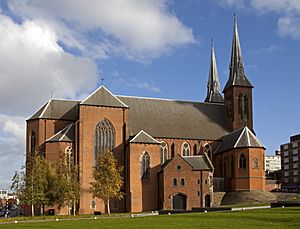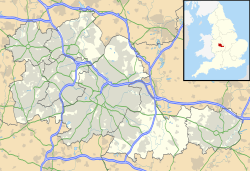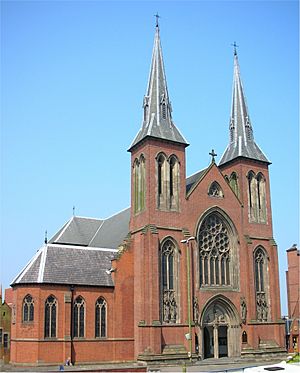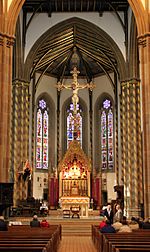St Chad's Cathedral, Birmingham facts for kids
Quick facts for kids St Chad's Cathedral, Birmingham |
|
|---|---|
| Metropolitan Cathedral and Basilica of St Chad | |
 |
|
| 52°29′08″N 1°53′55″W / 52.4855°N 1.8986°W | |
| Location | Birmingham, West Midlands |
| Country | England |
| Denomination | Catholic |
| Website | stchadscathedral.org.uk |
| History | |
| Consecrated | 1841 |
| Architecture | |
| Heritage designation | Grade II* listed |
| Designated | 25 April 1952 |
| Architect(s) | Augustus Welby Northmore Pugin |
| Style | Gothic Revival |
| Years built | 1839–1841 |
| Administration | |
| Diocese | Birmingham (since 1850) |
| Province | Birmingham |
The Metropolitan Cathedral Church and Basilica of Saint Chad is a Catholic cathedral in Birmingham, England. It is the main church for the Archdiocese of Birmingham and is named after Saint Chad of Mercia.
This cathedral was designed by Augustus Welby Pugin and was mostly finished by 1841. St Chad's was one of the first four Catholic churches built after the English Reformation. It became a cathedral in 1852. It is also one of only four minor basilicas in England.
St Chad's is a Grade II* listed building. This means it is a very important historic building. It is located in a public park area near St Chad's Queensway in central Birmingham. The current Archbishop of Birmingham is Bernard Longley.
Contents
History of St Chad's Cathedral
St Chad's was one of the first Catholic cathedrals built in England after the English Reformation. This big change started in 1534 under King Henry VIII. Bishop Thomas Walsh wanted St Chad's Cathedral built. He was the local Catholic leader.
The famous architect Augustus Welby Pugin designed St Chad's Cathedral. Building started in October 1839. The church was officially opened on June 21, 1841. A rich Catholic, John Talbot, 16th Earl of Shrewsbury, gave a lot of money for the project.
In 1852, the church became a cathedral. This happened after the Catholic Church was allowed to set up its system again in England. This was done by Pope Pius IX in 1850. The first bishop of Birmingham was William Bernard Ullathorne. Later, in 1911, the area became an archdiocese.
During World War II, the cathedral was in danger. It was bombed on November 22, 1940. An incendiary bomb fell through the roof. Luckily, it hit heating pipes, which burst and put out the fire. A special tablet in the ceiling says Deo Gratias 22 Nov 1940, meaning 'Thanks be to God'.
In 1941, Pope Pius XII declared St Chad's a minor basilica. This means it is a church with important historical links. It is one of only two such churches in England. On special days, a golden bell tower (the tintinnabulum) and a small striped umbrella (the conopaeum) are shown. These are official symbols of a basilica.
St Chad: The Cathedral's Patron Saint
The cathedral is named after St Chad. He was a bishop in the 7th century in a region called Mercia. He was also a student of St Aidan of Lindisfarne.
The cathedral holds some of St Chad's long bones. These are called relics. They were saved from Lichfield Cathedral around 1538. This happened during the Reformation when many churches were damaged. A priest named Arthur Dudley saved the bones.
The bones were passed down through his family. In 1651, a farmer named Henry Hodgetts was dying. He told a priest that St Chad's bones were in his bed. He asked his wife to give the box of relics to the priest. The priest took them to a seminary in France.
Later, in the 19th century, the relics came back to England. They ended up with Sir Thomas Fizherbert-Brockholes. After he died, his chaplain found the dusty box of relics. He gave them to Bishop Walsh. This is how the relics of St Chad, the apostle of the Midlands, came to be in the cathedral.
In 1985, scientists tested the bones. They used carbon dating. The tests showed that most of the bones were from the 7th century. This matches when St Chad died, on March 2, 672 AD.
Architecture and Design of St Chad's
Augustus Welby Pugin was chosen to design St Chad's. He became one of England's most famous Gothic Revival architects. Pugin became Catholic in 1835. He spent his life designing Catholic churches and their decorations.
St Chad's was the first large church he designed to be a cathedral. Pugin put a lot of effort into the building. He wrote about its architecture, decoration, and furnishings.
St Chad's replaced a smaller church built in 1808. The new cathedral was built on a narrow, sloping piece of land. Because of this, and because it had to be built with brick, Pugin had to be creative. He wanted the church to feel open and spacious.
He looked at churches built in Northern Germany in the late Middle Ages for ideas. St Chad's is built like a brick hall church or "Hallenkirche". It has tall, narrow spires like those in Lübeck Cathedral. Because the land sloped steeply, Pugin built a large crypt underneath. This was used for burials and is now a choir rehearsal room.
The cathedral's "east end" (where the altar is) actually faces northwest. This is an unusual direction for a church.
The inside of the church is very tall. The main area, called the nave, is almost twice as high as it is wide. It has high arches supported by thin columns. Some columns in the chancel (the area near the altar) are decorated with gold and a spiral pattern. They have a Latin phrase meaning 'Holy, Holy, Holy, Lord God of Hosts'.
The wooden ceiling is blue and has curved beams. It is decorated with patterns and flowers. These designs were inspired by old medieval ceilings in other cathedrals. The decoration is so delicate it looks like fabric.
Pugin designed many parts of the church's interior. This includes the main altar and the choir screen. The Bishop's Chair was also designed by Pugin. Other items, like the 16th-century pulpit, came from churches in Belgium and Germany. These were given to the cathedral by the Earl of Shrewsbury.
The stained-glass windows in the sanctuary were made by William Warrington. Other metalwork and decorations were made by Hardman & Co.. John Hardman was a member of St Chad's church. He started the Cathedral Choir in 1854.
In 1932, St Chad's added St Edward's Chapel. Pugin's grandson, Sebastian Pugin Powell, designed it. The chapel's windows show the history of St Chad's relics.
In the 1960s, some of Pugin's original designs were changed. The choir screen was removed. Other items were moved to different churches. The cathedral today looks different from Pugin's original vision. However, its beauty still shows the skill of its first designers.
Music at St Chad's
The Organ
The cathedral has a large organ built in 1993 by J. W. Walker & Sons Ltd. It is located at the west end of the cathedral. The organ case was designed by David Graebe. This organ is considered one of the best mechanical organs in the country.
There are regular organ concerts throughout the year. The organ is also used for teaching students from Birmingham Conservatoire. The current organist and director of music is David Saint.
Current Music Leaders
- Director of Music: David Saint
- Assistant Director of Music: Nigel Morris
- Organ Scholar: Dylan McCaig
The Choir
St Chad's has had a choir since 1854. It was first supported by John Hardman. He was a singer in the choir for many years. Today, the choir has adult men and women. They lead the singing at the Sunday Solemn Mass.
The choir sings many types of music. They are known for Latin polyphonic music from the Renaissance period. They also sing a wide range of Masses and motets in English and Latin. The choir sometimes performs concerts and has been on TV and radio.
The Bells
In 1840, St Chad's received one large bell. In 1848, this metal was used to make five new bells. These bells were made by Mears of Whitechapel. They were hung in the north-west tower.
In 1877, three more bells were added. All eight bells were first rung on Easter Sunday that year. In 1940, the bells were remade by Taylors of Loughborough. The eight bells play a diatonic octave. The heaviest bell weighs about 15 tons. They are rung regularly on Sunday mornings and for other important services.
Location of the Cathedral
The cathedral is in a green public area. It is near Birmingham Snow Hill railway station. The road next to it is called St Chad's Queensway. This road was built in the 1970s. The cathedral is on the north side of the road. In January 2017, a nearby tram stop was named St Chads.
Important Burials
- Chad of Mercia (c. 634–672): His relics are enshrined above the altar.
- Thomas Walsh (1777–1849): He was buried in the crypt chapel. A large memorial to him, designed by Pugin, is in the North aisle of the Cathedral.
See also
 In Spanish: Catedral de San Chad (Birmingham) para niños
In Spanish: Catedral de San Chad (Birmingham) para niños







